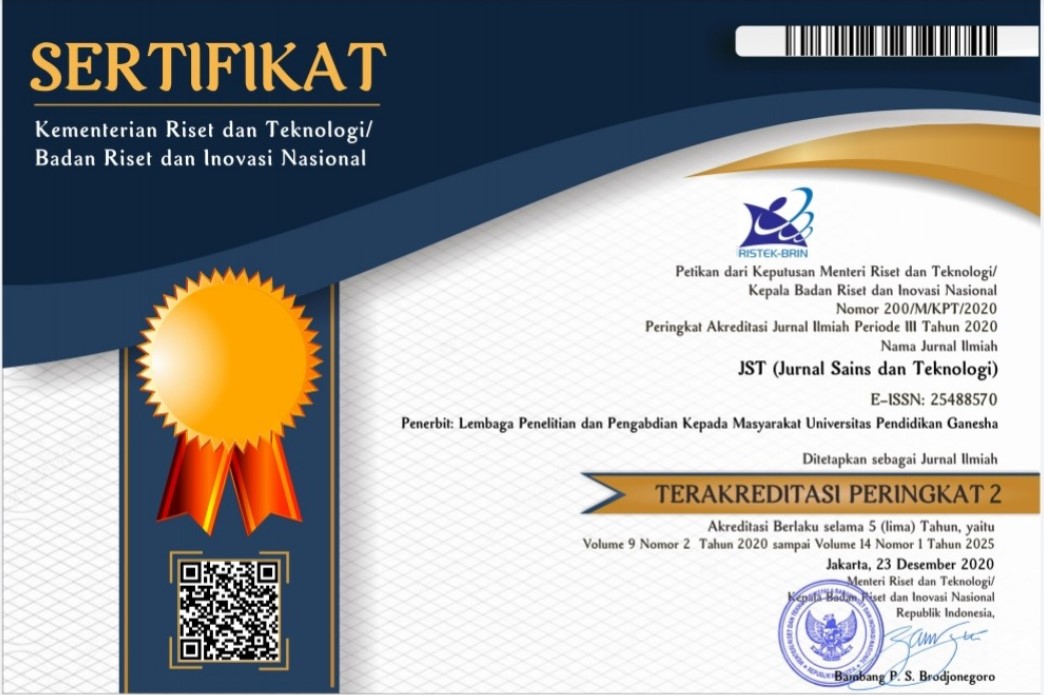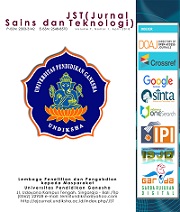Manajemen Pengondisian Suhu Ruangan Berdasarkan Beban Termal Menggunakan Sensor Thermopile Infrared Array
DOI:
https://doi.org/10.23887/jstundiksha.v13i2.83996Keywords:
AMG8833, Air Conditioner, Body Temperature Sensing, Kamera Termal, Thermal LoadAbstract
Upaya mencapai efisiensi energi, perlu pengurangan penggunaan AC yang tidak efisien, mengakibatkan konsumsi energi tinggi dan emisi karbon. Beban termal adalah total panas yang harus dikeluarkan dari ruangan untuk mempertahankan suhu nyaman, termasuk beban kalor sensibel dan laten. Tujuan penelitian ini untuk menganalisis manajemen pengondisian suhu ruangan berdasarkan beban termal menggunakan sensor thermopile infrared array. Jenis penelitian merupakan studi literatur. Sistem otomatisasi berbasis kamera termal AMG8833 dengan resolusi 8x8 piksel dikembangkan untuk mendeteksi kondisi ruangan secara efisien. ESP32 digunakan sebagai mikrokontroler untuk mengolah data dari kamera termal dan mengubah set point suhu ruangan menggunakan IR Transmitter. Pengaturan suhu dilakukan dengan mengatur fan AC berdasarkan hukum konveksi, sehingga distribusi udara lebih efektif. Sistem ini dilengkapi antarmuka dan LCD untuk pemantauan real-time serta pengubahan suhu langsung. Pengujian menunjukkan bahwa sistem berhasil mengoptimalkan suhu dan kenyamanan termal dengan penghematan daya 0.365 kWh. Sistem ini tidak hanya mengurangi konsumsi daya dan emisi karbon, tetapi juga meningkatkan kenyamanan dan produktivitas penghuni ruangan.
References
Aditya, F. (2021). Perubahan Tingkat Kenyamanan Berdasarkan Indeks Panas (Humidex) di Kalimantan Barat. Megasains, 12(1), 8–16. https://doi.org/10.46824/megasains.v12i1.47. DOI: https://doi.org/10.46824/megasains.v12i1.47
Alam, W. O. S. N., Aliansyah, A. N., Larobu, F. E., Mulyawati, L., Asminar, A., & Galugu, I. (2022). Tingkat akurasi Sensor AMG8833 dan Sensor MLX90614 dalam Mengukur Suhu Tubuh. JTEV (Jurnal Teknik Elektro Dan Vokasional), 8(1), 169. https://doi.org/10.24036/jtev.v8i1.114543. DOI: https://doi.org/10.24036/jtev.v8i1.114543
Albertus, M., & Muliady. (2020). Pengaturan Fan Speed dan Suhu Air Conditioner Melalui Ucapan Dengan Layanan Google Assistant API. TESLA: Jurnal Teknik Elektro. https://doi.org/10.24912/tesla.v21i2.7189. DOI: https://doi.org/10.24912/tesla.v21i2.7189
Almaududi, M. (2020). Pengaruh Laju Aliran Udara Masuk Evaporator Terhadap Kapasitas Pendinginan (Coefficient Of Performance) Dan Kelembapan Udara Pada Sistem Refrigerasi Air Condition. Edu Elektrika Journal, 9(1), 19–23. https://journal.unnes.ac.id/sju/eduel/article/view/32943.
Amri, S., Hadi, A., Gustiadi Putra, K., Negeri Bengkalis, P., Bathin Alam, J., & Alam, S. (2021). Penggunaan Sensor AMG8833 Pada Robot Penjaga Pintu Masuk Gedung Elektro Untuk Penerapan Protokol Kesehatan Covid-19. Jurnal INOVTEK Polbeng, 6(2). https://doi.org/10.35314/isi.v6i2.2160. DOI: https://doi.org/10.35314/isi.v6i2.2160
Baldwin, J. W., Benmarhnia, T., Ebi, K. L., Jay, O., Lutsko, N. J., & Vanos, J. K. (2023). Humidity’s Role in Heat-Related Health Outcomes: A Heated Debate. Environmental Health Perspectives, 131(5). https://doi.org/10.1289/EHP11807. DOI: https://doi.org/10.1289/EHP11807
Burhanuddin, A., Malik, M., & Setyoadi, Y. (2023). Prototype Of Mask Recognition And Body Temperature In Real Time With Amg8833 Thermal Cam Sensor For Covid-19 Early Warning Based On Minicomputer. Journal of Biomedical Science and Bioengineering, 2(2), 43–49. https://doi.org/10.14710/jbiomes.2.2.43-49.
Chairani, Sulistyo, S., & Widyawan. (2017). Cooling Load Estimation in the Building Based on Heat Sources. IOP Conference Series: Earth and Environmental Science, 63(1). https://doi.org/10.1088/1755-1315/63/1/012052. DOI: https://doi.org/10.1088/1755-1315/63/1/012052
Cheng, C.-C., & Lee, D. (2016). Enabling Smart Air Conditioning by Sensor Development: A Review. Sensors, 16(12), 2028. https://doi.org/10.3390/s16122028. DOI: https://doi.org/10.3390/s16122028
Choudhary, B., & Udayraj. (2023). Local and overall convective heat transfer coefficients for human body with air ventilation clothing: Parametric study and correlations. Building and Environment, 229, 109953. https://doi.org/10.1016/j.buildenv.2022.109953. DOI: https://doi.org/10.1016/j.buildenv.2022.109953
Furizal, S., & Yudhana, A. (2023). Temperature and Humidity Control System with Air Conditioner Based on Fuzzy Logic and Internet of Things. Journal of Robotics and Control (JRC), 4(3), 308–32. https://doi.org/10.18196/jrc.v4i3.18327. DOI: https://doi.org/10.18196/jrc.v4i3.18327
Geneva, I. I., Cuzzo, B., Fazili, T., & Javaid, W. (2019). Normal Body Temperature: A Systematic Review. Open Forum Infectious Diseases, 6(4). https://doi.org/10.1093/ofid/ofz032. DOI: https://doi.org/10.1093/ofid/ofz032
Heriyadi, B., & Salia Zakri, R. (2021). Evaluation and Analysis of Needs for Air Ventilation Systems in Underground Coal Mine (Case Study in Underground Coal Mine, Sawahlunto City). Journal of Physics: Conference Series, 1940(1), 012077. https://doi.org/10.1088/1742-6596/1940/1/012077. DOI: https://doi.org/10.1088/1742-6596/1940/1/012077
Jati, I. S., & Rivai, M. (2020). Implementasi Thermal Camera pada Pengaturan Pendingin Ruangan. Jurnal Teknik ITS, 8(2). https://doi.org/10.12962/j23373539.v8i2.43131. DOI: https://doi.org/10.12962/j23373539.v8i2.43131
Kemala, A. P., Syahputra, M. E., Lucky, H., & Achmad, S. (2022). Pengembangan Smart Air Condition Control Menggunakan Platform Blynk Berbasis Mikrokontroler ESP8266 dan Sensor DHT11. Engineering, MAthematics and Computer Science (EMACS) Journal, 4(1), 19–23. https://doi.org/10.21512/emacsjournal.v4i1.8072. DOI: https://doi.org/10.21512/emacsjournal.v4i1.8072
Khairunsyah, H., Solikhun, S., Nasution, Z. M., Damanik, B. E., & Parlina, I. (2021). Prototype Sistem Kendali Jarak Jauh Air Conditioner Berbasis Arduino dan Wifi. Jurnal Penelitian Inovatif, 1(2), 75–84. https://doi.org/10.54082/jupin.13. DOI: https://doi.org/10.54082/jupin.13
Legionosuko, T., Madjid, M. A., Asmoro, N., & Samudro, E. G. (2019). Posisi dan Strategi Indonesia dalam Menghadapi Perubahan Iklim guna Mendukung Ketahanan Nasional. Jurnal Ketahanan Nasional, 25(3), 295. https://doi.org/10.22146/jkn.50907. DOI: https://doi.org/10.22146/jkn.50907
Leni, D. (2023). Analisis Heatmap Korelasi dan Scatterplot untuk Mengidentifikasi Faktor-Faktor yang Mempengaruhi Pelabelan AC efisiensi Energi. Jurnal Rekayasa Material, Manufaktur Dan Energi, 6(1), 41–47. https://doi.org/10.30596/rmme.v6i1.13133. DOI: https://doi.org/10.30596/rmme.v6i1.13133
Li, B., Liu, J., & Ying, B. (2021). Physical education interventions improve the fundamental movement skills in kindergarten: a systematic review and meta-analysis. Food Science and Technology, 42. https://doi.org/10.1590/fst.46721. DOI: https://doi.org/10.1590/fst.46721
Liang, R., Le-Hung, T., & Nguyen-Thoi, T. (2022). Energy consumption prediction of air-conditioning systems in eco-buildings using hunger games search optimization-based artificial neural network model. Journal of Building Engineering, 59, 105087. https://doi.org/10.1016/j.jobe.2022.105087. DOI: https://doi.org/10.1016/j.jobe.2022.105087
Lovita, W., Aulia, & Junaldi. (2022). Sistem Pengukuran Suhu Tubuh Menggunakan AMG8833 Dan Kinect Sebagai Pencegahan Penularan Covid-19. Jurnal RESTI (Rekayasa Sistem Dan Teknologi Informasi), 6(1), 100–107. https://doi.org/10.29207/resti.v6i1.3687. DOI: https://doi.org/10.29207/resti.v6i1.3687
Maluegha, B. L., & Luntungan, H. (2021). Penentuan Beban Pendinginan AC untuk Memilih Sistem Pendinginan yang Hemat Energi pada Ruangan Ibadah Gedung Gereja KGMPI Getsemani Kelurahan Bahu Kota Manado. Jurnal Tekno Mesin, 7(2). https://ejournal.unsrat.ac.id/index.php/jtmu/index.
Munawaroh, A. S., & Elbes, R. (2019). Penilaian kenyamanan termal pada bangunan perpustakaan Universitas Bandar Lampung. ARTEKS : Jurnal Teknik Arsitektur, 4(1), 85–98. https://doi.org/10.30822/arteks.v4i1.83. DOI: https://doi.org/10.30822/arteks.v4i1.83
Mustamin, M. T., Rahim, R., Hamzah, B., & Mulyadi, R. (2020). The Effect of Human Body Surface Area on Thermal Comfort of University Students. International Journal of Advanced Research in Engineering and Technology (IJARET), 11(9), 495–504. https://doi.org/10.34218/IJARET.11.9.2020.050.
Nurhilal, O., Suryaningsih, S., Faizal, F., & Sharin Lesmana, R. (2020). Pemanfaatan Eceng Gondok sebagai Adsorben Pb Asetat. Jurnal Ilmu Dan Inovasi Fisika, 4(1), 46–52. https://doi.org/10.24198/jiif.v4i1.26150. DOI: https://doi.org/10.24198/jiif.v4i1.26150
Putri, I., Nurfajriyani, I., & Fadilatussaniatun, Q. (2020). Pengaruh Suhu Ruangan Kelas Terhadap Konsentrasi Belajar Mahasiswa Pendidikan Biologi Semester VII (B). BIO EDUCATIO : (The Journal of Science and Biology Education), 5(1). https://doi.org/10.31949/be.v5i1.1744. DOI: https://doi.org/10.31949/be.v5i1.1744
Quraisy, S., Rizal, M., & Tayeb, M. (2019). Kajian Kenyamanan Termal Ruang Kelas Studio Perancangan Jurusan Teknik Arsitektur Di Kampus Ii Unkhair. Jurnal Lingkungan Binaan Indonesia, 8(4). https://doi.org/10.32315/jlbi.v8i4.137. DOI: https://doi.org/10.32315/jlbi.v9i4.137
Saint Akadiri, S., Adewale Alola, A., Olasehinde-Williams, G., & Udom Etokakpan, M. (2020). The role of electricity consumption, globalization and economic growth in carbon dioxide emissions and its implications for environmental sustainability targets. Science of The Total Environment, 708, 134653. https://doi.org/10.1016/j.scitotenv.2019.134653. DOI: https://doi.org/10.1016/j.scitotenv.2019.134653
Sangsawang, T. (2020). An instructional design for online learning in vocational education according to a self-regulated learning framework for problem solving during the covid-19 crisis. Indonesian Journal of Science and Technology, 5(2), 283–198. https://doi.org/10.17509/ijost.v5i2.24702. DOI: https://doi.org/10.17509/ijost.v5i2.24702
Simamora, A. M., & Siringo- ringo, K. (2023). Rancang Bangun Switch Control Thermostat Pada Water Heater Kapasitas 10 Liter Dengan Daya 300 Watt. Jurnal Al Ulum LPPM Universitas Al Washliyah Medan, 11(1), 21–28. https://doi.org/10.47662/alulum.v11i1.434. DOI: https://doi.org/10.47662/alulum.v11i1.434
Susanti, N., Ronando, E., Basyarach, N. A., Sulistyawati, D. H., & Widiasih, W. (2022). Analysis of the effect of the MBKM Internship Program and Certified Independent Study (MSIB) on university performance Universitas 17 Agustus 1945 Surabaya. Technium Social Sciences Journal, 27. https://doi.org/10.47577/tssj.v27i1.5586. DOI: https://doi.org/10.47577/tssj.v27i1.5586
Widodo, J., Naryanto, H. S., Hidayat, N., Putra, A. P., Izumi, Y., Perissin, D., & Sumantyo, J. S. (2021). Land Subsidence Assessment of Bandung City, Indonesia in Geological Perspective, Based on Interferometric SAR Using C-band Data. In 2021 Photonics & Electromagnetics Research Symposium (PIERS), 2377–2381. https://doi.org/10.1109/PIERS53385.2021.9694892. DOI: https://doi.org/10.1109/PIERS53385.2021.9694892
Zhao, Z., Wang, J., Fu, C., Liu, Z., Liu, D., & Li, B. (2018). Design of a smart sensor network system for real-time air quality monitoring on green roof. Journal of Sensors. https://doi.org/10.1155/2018/1987931. DOI: https://doi.org/10.1155/2018/1987931
Downloads
Published
How to Cite
Issue
Section
License
Copyright (c) 2024 Nuryanti, Susetyo Bagas Bhaskoro, Muhammad Firza Erliansyah

This work is licensed under a Creative Commons Attribution-ShareAlike 4.0 International License.
Authors who publish with the Jurnal Sains dan Teknologi (JST) agree to the following terms:
- Authors retain copyright and grant the journal the right of first publication with the work simultaneously licensed under a Creative Commons Attribution License (CC BY-SA 4.0) that allows others to share the work with an acknowledgment of the work's authorship and initial publication in this journal.
- Authors are able to enter into separate, additional contractual arrangements for the non-exclusive distribution of the journal's published version of the work (e.g., post it to an institutional repository or publish it in a book), with an acknowledgment of its initial publication in this journal.
- Authors are permitted and encouraged to post their work online (e.g., in institutional repositories or on their website) prior to and during the submission process, as it can lead to productive exchanges, as well as earlier and greater citation of published work. (See The Effect of Open Access)















